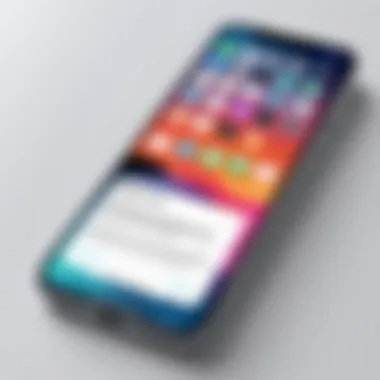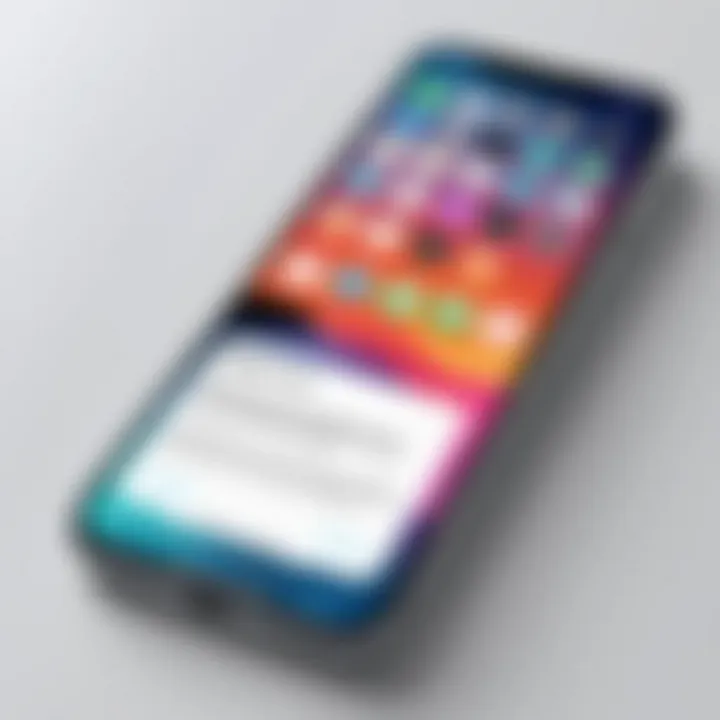Does Apple Recommend Antivirus for iPhone?


Intro
In today’s digital landscape, the notion of security hangs like a dark cloud over most conversations about smartphones. Given the rapid evolution of tech and the threats that come with it, questions surrounding the need for antivirus software on devices like the iPhone have gained traction. Beneath the slick veneer of sophistication presented by Apple's iOS, lies a complex interplay of security measures, yet the question remains: is that enough?
Overview of Cyber Security Threats
Cybersecurity isn't merely a buzzword; it's a critical necessity in the age of smartphones. With the increasing reliance on mobile devices, users must be keenly aware of the various threats lurking in the digital environment.
Types of Cyber Threats
Common threats include:
- Malware: This harmful software can steal information or damage systems without the user's knowledge.
- Phishing: A tactic where cybercriminals masquerade as legitimate entities to extract sensitive data.
- Ransomware: This is a more malicious approach, where the perpetrator locks an individual's files, demanding payment for their release.
Statistics on Cyber Attacks
Reports have shown a staggering increase in cyber incidents. For instance, studies indicate that phishing attacks alone have risen by more than 600% since the pandemic began. Such alarming data highlights the urgency for mobile users to stay vigilant.
Real-life Examples of Security Breaches
Consider the infamous Target data breach in 2013, where hackers gained access through a third-party vendor. Millions of credit card details were exposed, leading to a loss of consumer trust and a financial hit for the company. Similarly, the Equifax breach in 2017 compromised the personal information of over 147 million people, emphasizing that no entity is immune.
Best Practices for Online Security
Adopting best practices can significantly bolster your defenses against online threats. Here are some critical strategies:
- Create Strong Passwords: Use a mix of letters, numbers, and symbols. Consider employing a password manager to track them securely.
- Update Regularly: Software updates often patch vulnerabilities that hackers exploit, so make it a habit to keep your iPhone up-to-date.
- Enable Two-Factor Authentication: This adds an extra layer of security, making unauthorized access far more difficult.
Evaluating Antivirus Necessity
While Apple's official stance on antivirus software for iPhones leans towards skepticism, discerning whether you need one requires deeper scrutiny. The iOS ecosystem has built-in defenses, but external threats still exist.
Alternative Security Measures Recommended By Apple
Instead of relying heavily on antivirus software, Apple suggests users focus on these core areas for enhanced security:
- Use Find My iPhone to locate lost devices.
- Take advantage of iCloud Keychain for password and sensitive information storage.
- Leverage built-in security features like Face ID or Touch ID for additional protection.
Tips for Ensuring Online Privacy
Using your iPhone involves exchanging various personal data, and thus, privacy protection is paramount.
- Use VPNs: A Virtual Private Network masks your IP address, making your online activities harder to track.
- Beware of Social Media Privacy Settings: Check your privacy settings and limit sharing to only those who need to know.
- Be Cautious with Online Transactions: Only shop on secure websites, denoted by a padlock symbol in the browser address bar.
Educational Resources and Guides
Finally, to empower users, here are some reputable resources for enhancing your online security:
- How-to Articles: Websites like Wikipedia offer invaluable guides on various encryption tools.
- Step-by-step Guides: Ill-informed clicks can result in disastrous consequences. Guides on spotting phishing emails can be found at Britannica.
With a complex ecosystem of digital threats, understanding and applying these measures is not just wise, it’s essential. In a world where your iPhone holds your life—both personal and professional—being informed is your best line of defense.
Intro to iPhone Security
In today’s digital landscape, the necessity of securing our devices is greater than ever. With a significant portion of our lives conducted online—from banking to communication—understanding the security measures for smartphones is essential. iPhones, particularly due to their popularity and the trust placed in the Apple brand, often become focal points for discussions around cybersecurity. This section lays the groundwork for why understanding iPhone security matters. It examines threats that iPhone users commonly face and underscores the significance of implementing protective measures.
Overview of Cybersecurity Concerns
Cyber threats are omnipresent, evolving continuously in sophistication and technique. While iPhones come equipped with a range of security features designed to safeguard users, vulnerabilities still exist. For instance, phishing attacks present a clear and present danger. Scammers employ various methods to deceive users into providing sensitive information, thus compromising their privacy. Furthermore, as online platforms grow, so does the risk of malware infiltrating mobile devices, including scams dressed as legitimate applications. YouTube has been noted for hosting deceptive apps that claim to enhance device performance, but instead, they often host malicious code.
Besides external threats, the potential for data breaches, whether through networks or personal accounts, raises red flags. As reputable as Apple is, no system is foolproof. Many users mistakenly assume that their iPhones are impervious to cyber threats, leading to a lax attitude towards security practices. Understanding these concerns enables users to engage more critically with the security landscape surrounding their devices and take proactive steps to defend against potential risks.


Importance of Device Protection
Device protection isn’t just a nicety; it's a necessity. The ramifications of a security breach can be profound, leading to financial loss, identity theft, or emotional distress. Every piece of sensitive data stored on a device—contacts, messages, payment information—requires protection. Without robust defenses, this information becomes vulnerable to exploitation.
Moreover, in a world increasingly reliant on technology, user behavior plays a critical role in security. Installing apps from unverified sources or clicking on dubious links can expose devices to peril. Thus, users must not only recognize the need for protection but also adopt diligent habits. Regular updates, reviewing app permissions, and utilizing built-in privacy features go a long way in maintaining security.
Engaging with these concepts helps foster habits that promote a safer digital existence, emphasizing that, while Apple provides substantial protection, user diligence is key in sealing any potential gaps.
"Security is not a product, but a process."
Apple's Position on Antivirus Software
In the ever-evolving landscape of mobile security, Apple’s stance on antivirus software is particularly significant. Given the popularity of the iPhone, understanding Apple's position is crucial for users who wish to safeguard their personal information and maintain privacy. The company emphasizes that the iOS operating system is designed with a robust built-in security architecture to minimize the risks associated with malware and other security threats.
Apple doesn’t typically advocate for antivirus applications on iPhones. This stance arises from the integration of security features directly into iOS. These features, which include sandboxing of apps and a strict app review process, aim to prevent malicious content from wreaking havoc on users’ devices. The importance of Apple's viewpoint lies in its focus on creating a more secure environment by default, rather than relying on third-party solutions that could potentially create additional vulnerabilities or false sense of security.
Moreover, by citing the security efficacy of its operating system, Apple encourages users to manage their digital safety through diligence and best practices, rather than depending solely on antivirus software. This approach promotes a responsible use of technology while emphasizing that users play a vital role in their own security.
Official Recommendations from Apple
Apple's official guidance on the subject is clear: the tech giant does not endorse the need for antivirus software on iPhones. According to various support documents, Apple indicates that the iPhone's architecture is purposely designed to be resistant to malware. This means that, under normal usage conditions, the chances of an iPhone being infected with malware are significantly low.
Apple's security features, like system updates, application vetting, and app sandboxing, provide layers of defense against potential threats. Users are encouraged to utilize these built-in features. For instance, keeping the iOS software up to date ensures that all security patches and improvements are applied promptly, closing any potential vulnerabilities that could be exploited.
"The best way to keep your iPhone secure is to use it wisely and keep your software up to date."
Instead of seeking external antivirus solutions, Apple suggests methods for protection that align with their built-in offerings. These include regularly updating devices, being wary of downloading apps from unverified sources, and staying cautious about sharing personal information online.
One popular myth that Apple aims to dispel is the idea that third-party antivirus apps can offer better protection than what iOS affords by default. Apple positions itself as the authority on iOS and emphasizes that iPhone users can count on the inherent protective measures embedded in the operating system.
Statements from Apple Executives
Statements from Apple executives further illuminate the company’s philosophy regarding antivirus software on the iPhone. During interviews and public talks, they consistently assert that the inherent design and structure of iOS minimize malware risk significantly. In their opinions, the combination of a managed app ecosystem and the continuous updates provided by Apple serves as a formidable defense mechanism against digital threats.
For instance, in a notable presentation, an Apple executive explained that the potential for malware targeting iOS is limited due to the stringent app validation and review process. In contrast to other operating systems, where users can face significant security challenges from widely varied sources, the controlled environment created by Apple fundamentally alters the landscape.
Moreover, Apple executives often highlight user education—what they call ‘smart usage’—as being equally important to technical measures. Emphasizing that even the best security features can be undermined by poor user practices, they advocate for a straightforward understanding of how to navigate iOS securely. This involves:
- Recognizing suspicious apps and websites
- Understanding privacy settings,
- Engaging in responsible sharing habits online
In summary, both the official recommendations and the statements from Apple executives showcase a clear, cohesive message: the iPhone’s design and operation significantly reduce the need for antivirus software. Their holistic approach stresses user awareness and the leveraging of built-in security features to maintain a secure mobile experience.
The iOS Security Architecture
Understanding the architecture behind iOS is crucial when evaluating the necessity of antivirus software for the iPhone. Apple's operating system, tailored specifically for its devices, boasts a robust framework designed to protect user data and privacy. Its inherent security measures are aimed at minimizing risks, ensuring that users can navigate their smartphones with confidence. The various layers of security built into iOS serve as the first line of defense against potential threats, making the concept of antivirus programs somewhat redundant for most users. However, recognizing the limitations of this architecture is equally important, as it reveals areas where additional caution may still be warranted.
Built-in Features for Security
iOS comes equipped with several built-in features aimed at safeguarding users. Understanding these elements can shed light on why Apple does not push for third-party antivirus solutions.
Sandboxing
One of the cornerstones of iOS security is sandboxing, a method that restricts applications to their own environments. This means that each app operates in its isolated space and cannot access data or functionalities of other applications directly. This separation is tremendously beneficial as it substantially reduces the risk of malicious software from affecting the broader system.
The key characteristic of sandboxing is its ability to limit an app’s permissions, making it challenging for harmful software to spread or collect sensitive information. The unique feature here is that even if an app is compromised or poorly designed, the potential damage it could inflict is confined within its own sandbox. This greatly enhances the overall integrity and resilience of the iOS environment.
App Review Process
Another significant aspect of iOS security is the App Review Process, which requires all applications to be vetted by Apple before they can be downloaded through the App Store. This ensures that new apps meet rigorous security standards, providing a layer of assurance for users. The fundamental characteristic of this process is its emphasis on preemptive screening of applications to identify potential threats.
What makes this feature unique is the ongoing scrutiny apps undergo; updates and new releases are also subject to review. However, while this helps reduce malware incidence, it does not eliminate all risks, as malicious apps can still slip through the cracks, albeit rarely.
Regular Software Updates


Keeping mobile operating systems up to date is another critical factor in enhancing security, and this is where regular software updates play a key role. iOS devices receive consistent updates from Apple, aimed at patching vulnerabilities and improving overall functionality. This practice is incredibly beneficial, as it means users are continually protected against the latest security threats.
The distinct feature of regular updates is that they happen seamlessly, often without users needing to intervene. However, while these updates provide vital protection, they can also introduce new software bugs or compatibility issues with older devices, highlighting a trade-off between security and user experience.
Limitations of the iOS Security Model
Despite the strong protective measures present within iOS, it is important to acknowledge that no system is entirely foolproof. The security model has its own set of limitations. For instance, while sandboxing effectively isolates apps, it cannot prevent users from inadvertently installing malicious applications that may misuse their permissions once installed. Furthermore, the reliance on app reviews means that malicious entities are ever-evolving, finding new ways to bypass this gatekeeping.
Recognizing Security Risks on iPhones
Understanding security risks on iPhones is not just a wise move; it's a necessity. With the growing amount of sensitive personal data stored on these devices, it's critical to acknowledge the vulnerabilities that could compromise user privacy. Cyber threats continue to evolve, and recognizing these risks enables users to take proactive steps to protect their devices. Ignorance can lead to severe consequences, so being informed is like wearing a life preserver in shark-infested waters.
Malware in the Mobile Ecosystem
YouTube Scam Apps
You might think of YouTube as a safe haven for entertainment, but not all that glitters is gold. YouTube scam apps have become a nuisance in the mobile landscape. These apps often masquerade as legitimate, using familiar branding to lure unsuspecting users. They can promise everything from ad-free viewing to exclusive content, but ultimately, they can lead to malicious activities such as data harvesting and unwanted advertisements.
The key characteristic of these scam apps is their deceptive nature. They often rely on social engineering tactics, encouraging users to download them under the guise of enhancing their viewing experience. People are naturally drawn to anything that appears to offer convenience or added features, making these scam apps particularly effective.
One unique feature of YouTube scam apps is their agility—they can be created and taken down quickly, making it difficult for users to keep up. The advantage here, from a malicious standpoint, is that these apps can evade detection for longer periods, putting users at greater risk.
Fake Antivirus Software
Another area of concern is fake antivirus software, a real thorn in the side for unsuspecting iPhone users. These applications often claim to protect your device from all sorts of threats, instilling a false sense of security. They promise to clean up unwanted files or block malware, but in reality, they can be as dangerous as the very threats they claim to defend against.
The discernible trait of fake antivirus apps is their intrusive behavior; they usually request extensive permissions that grant them access to private data. This creates the perfect storm for identity theft and data loss. From the standpoint of this article, understanding these risks helps signal the necessity of discernment when it comes to downloading new apps.
The unique feature of these fake antivirus programs lies in their ability to exploit panic and concern—many users are understandably worried about security, making them prone to gullibility. While these applications may boast short-term advantages, like claiming to boost performance, the long-term disadvantages far outweigh them. Instead of protection, users end up opening the floodgates for more vulnerabilities.
Potential Security Threats
Phishing Attacks
Phishing attacks are a cunning enemy in the realm of online security. These attacks often involve deceptive emails or messages that look like they belong to legitimate sources. The goal? To trick users into revealing sensitive information, such as passwords and bank details. They can appear unexpectedly and masquerade as trustworthy messages from banks, service providers, or even friends, stirring anxiety and concern over account security.
The hallmark of phishing attacks is their ability to mimic genuine correspondence so closely that even the most vigilant individuals can fall prey. This characteristic makes them a pertinent topic for discussion in this article; raising awareness can be the first line of defense.
One unique feature of phishing is its adaptability. Scammers will often use current events—like holidays or significant news stories—to lure people into clicking. It's a useful reminder that users must always verify the source of any communication before acting on it. The advantages of being knowledgeable about such tactics are clear: when users are aware of the signs, they can better guard their personal information against would-be thieves.
Public Wi-Fi Risks
Using public Wi-Fi may feel harmless, but it can open users up to a world of risk. Those cozy cafes or bustling airports often have networks that aren’t secure, making it easy for data snoopers to intercept communications. Insecure networks become virtual pickpockets in the tech world, allowing cybercriminals to access sensitive data as it travels over the airwaves.
The glaring characteristic of public Wi-Fi risks lies in its convenience, coupled with a false sense of security—just because a network pops up on your device, it doesn't mean it's safe. This concern is essential for anyone interested in maintaining their privacy and security, which ties back to the focus of this article.
A unique feature of public Wi-Fi is its accessibility; people are frequently unaware of the risks because they prioritize convenience. Those tempting free connections can lead to dire consequences, such as identity theft or data breaches. Understanding these risks allows users to make informed choices about where and how they connect, ensuring their information remains as safe as possible.
Evaluating the Need for Antivirus Software
When it comes to mobile device security, specifically with iPhones, the topic of antivirus software often sparks lively debate. There’s a fine line between feeling secure and taking unnecessary precautions. The evaluation of the need for antivirus software on an iPhone doesn’t merely hinge on whether such solutions are available; it encompasses a broader understanding of user behavior, potential security threats, and the inherent defenses of the iOS ecosystem.
Understanding Your Usage
Every iPhone user has a different set of habits. For some, the iPhone is a personal device used mainly for communication and occasional browsing. For others, it may serve as a hub for sensitive transactions and critical communications. Thus, the decision about antivirus software must acknowledge individual usage patterns. Engaging in risky behavior—downloading apps from unofficial sources or clicking on suspicious links—can warrant a reevaluation of one’s security posture.
Benefits of Antivirus Solutions
Installing antivirus software can often provide several advantages, including but not limited to:
- Real-time scanning: Many solutions offer continuous monitoring for risky activities, potentially catching threats as they appear.
- Web protection: Some antivirus apps have features that block malicious websites, preventing phishing scams and malware downloads.
- Privacy tools: Certain software comes with added privacy features, like VPN services, which enhance overall online safety.
Considerations Beyond Antivirus
While considering antivirus, it’s also crucial to think about other security measures. The built-in features of iOS, such as sandboxing and the App Store review process, inherently protect the user. Making the most of these tools should be part of any evaluation before settling on antivirus software as the first line of defense.
"A strong castle needs both solid walls and keen guards."
Many users might overlook the potential advantages of implementing simple daily practices—things like keeping the device updated or using recommended security features. In light of this, it’s important to not just ask if antivirus is necessary but also to look at the whole picture of smartphone security.


When to Consider Antivirus Solutions
An appropriate time to think about antivirus solutions emerges when user habits intersect with risk factors. Situations that can trigger this consideration include:
- Frequent use of public Wi-Fi: Regularly connecting to unsecured networks can expose your device to numerous threats.
- Installing apps from third-party sources: If you find yourself sideloading apps, this increases vulnerability to malware.
- Handling sensitive information: If you use your iPhone for banking or storing confidential documents, incorporating antivirus may provide an all-important additional layer of security.
In these contexts, anyone who feels unease about their device's security may feel reassured by the proactive measures that antivirus software can provide.
Limitations of Mobile Antivirus Apps
While the arguments supporting antivirus software are compelling, it’s vital to examine their limitations too. These include:
- Limited effectiveness on iOS: Given iOS’s strict security protocols, many traditional antivirus solutions may offer reduced functionality compared to their capabilities on other platforms.
- Resource consumption: Antivirus apps can consume significant system resources, potentially slowing down device performance—a risk not everyone is willing to take.
- False sense of security: Relying solely on antivirus software might lead users to become complacent about basic security practices, such as avoiding suspicious links or ensuring their apps are from trusted sources.
In summary, while it’s insightful to weigh the pros and cons of embracing antivirus solutions for iPhones, it’s clear that making an informed decision should consider a range of factors—from personal usage to understanding the limitations of both iOS and antivirus apps themselves.
Alternative Security Measures Recommended by Apple
Apple emphasizes a multi-layered approach to keeping its users safe, especially in a world where cyber threats are rampant. While some may ponder the necessity of antivirus software, numerous alternative security measures lie at the heart of Apple’s strategy. These methods not only protect the device but also empower users to take control of their own digital safety.
Using Built-in Privacy Features
Apple Security
Apple ID security stands out as a pivotal component in the realm of Apple’s security measures. At its core, an Apple ID acts as a gateway to all Apple services, encompassing everything from iCloud to the App Store. One key characteristic of Apple ID security is its ability to safeguard personal data through a robust password and account recovery options. This means even if someone tries to gain unauthorized access, they will find it challenging without the right credentials.
A unique feature of Apple ID is the security questions plus a backup method for account recovery. This adds an extra layer of competence to its overall security architecture. However, unlike some traditional means, these questions can sometimes be guessed or answered incorrectly, leaving some vulnerability. But the benefits it provides—keeping personal information under lock and key—far outweigh this minor disadvantage.
Two-Factor Authentication
Two-Factor Authentication (2FA) serves as another essential element in Apple’s security toolkit. This method ensures that accessing an Apple ID from a new device requires not just a password but also a unique code sent to a trusted device. The presence of such extra measures significantly lowers the chance of unauthorized access.
The distinctive characteristic of 2FA is the seamless link between your devices. You can set a trusted iPhone, iPad, or Mac to always receive the verification code when you log in, making it both useful and practical. Yet, a potential downside is the inconvenience some users might face when away from their primary devices. However, the trade-off is a heightened safety net that protects the user’s data, making it a highly valuable choice for maintaining security and privacy.
Best Practices for Safe Browsing
Browser Security Settings
When engaging in online activities, browser security settings wield a significant role. These settings control what information is shared when users navigate the vast expanse of the internet. A key characteristic here is content blockers, which can prevent unwanted ads and trackers from profiling users. This is essential for limiting exposure to potential threats while browsing.
Moreover, a unique feature of browser security settings is the option to manage cookies. Users can choose to allow or block cookies based on their own comfort level, granting them a sense of control over their data. Although some sites may not function fully without cookies, the advantage of increased privacy often enhances user security in the long run.
Recognizing Unsafe Websites
An important aspect of being safe online is the ability to identify unsafe websites. This means being alert to signs like unusual URLs, lack of HTTPS, and poor grammar or spelling in website content. Users can spot potentially harmful sites by noting these features. The key characteristic here lies in the user's judgment, as intuition can sometimes serve as the best defense.
One of the advantages of knowing how to recognize unsafe websites is that it educates users not to click on suspicious links that can lead to malware or phishing attempts. However, a downside is that even some seemingly legitimate sites can harbor threats. This underscores the need for continued vigilance across all online engagements.
"An informed user is a secure user. Awareness can significantly reduce the likelihood of falling prey to cyber threats."
Culmination: Balancing Security and Convenience
The conversation around whether iPhone users need antivirus software often brings up various intertwined themes—security, convenience, and user behavior. In the realm of digital safety, there exists a fine line between protecting device integrity and allowing for a seamless experience. With Apple’s robust iOS architecture, many wonder if additional antivirus measures are truly necessary. Following Apple's own guidance, we delve into how users can navigate their security without sacrificing usability.
Security Measures vs. Usability
While security is paramount, it must not come at the expense of user experience. The strong built-in protections provided by iOS, such as continuous software updates, sandboxing, and app vetting processes, already create a fortified environment. This leads to the argument against a saturated ecosystem of third-party security applications, which can potentially slow down devices or create unnecessary distractions from routine usage.
The Importance of User Awareness
Education plays a pivotal role in maintaining security. Users must engage with their devices intentionally—be wary of malicious links, avoid sketchy apps, and exercise caution while using public networks. Therefore, while Apple may not advocate for heavy reliance on antivirus software, it does promote the idea that users must be proactive in their practices. Understanding one’s behavior can significantly alter the security landscape.
"When it comes to security, an informed user makes all the difference. Being preventive rather than reactive is key in today's digital age."
Final Recommendations
To strike a balance, users can implement certain practices:
- Engage with built-in features: Utilize features like Find My iPhone and Apple ID Security settings to fortify accounts.
- Adopt safe browsing habits: Exercise caution while clicking links or entering personal information.
- Stay updated: Keep iOS up to date to benefit from the latest security patches.
Final Thoughts on Antivirus for iPhone
In essence, Apple's stance on antivirus software encapsulates a broader philosophy: trust your device, but also trust yourself. Users need not feel pressured to layer their iPhones with excess security measures when many protections are already in place. Instead, prioritizing personal awareness, employing built-in security functionalities, and practicing safe digital habits is the most effective route to safeguard devices.
Ultimately, the need for antivirus on an iPhone should be viewed through a lens of personal comfort and necessity. If one feels increasingly vulnerable due to their mobile behavior or usage patterns, exploring additional antivirus options could be worthwhile. However, the prevailing sentiment remains clear: exercising caution and leveraging native iOS features is often sufficient for most users, allowing them to enjoy their devices without the weight of anxiety.







